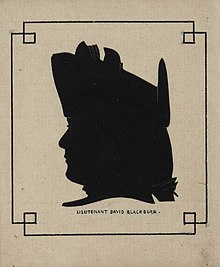HMAT Supply (1759)
 Replica of HMS Supply in Sydney Harbour in 1938
| |
| History | |
|---|---|
| Name | HMS Supply |
| Ordered | 4 April 1759 |
| Builder | Henry Bird, Rotherhithe |
| Laid down | 1 May 1759 |
| Launched | 5 October 1759 |
| Commissioned | 17 October 1759 |
| Decommissioned | 21 April 1792 |
| Out of service | 17 July 1792 |
| Fate | Sold out of Navy service for ₤600 |
| Name | Thomas and Nancy |
| Acquired | 1792 by purchase for ₤600 |
| Fate | Last listed in 1806 |
| General characteristics | |
| Class and type |
|
| Tons burthen | 174 76⁄94 (bm) |
| Length | |
| Beam | 22 feet 6 inches (6.9 m)* |
| Depth of hold | 11 feet 6 inches (3.5 m)* |
| Propulsion | Sail |
| Complement |
|
| Armament |
|


Launched in 1759, the third HMS Supply was a Royal Navy armed tender that played an important part in the foundation of Australia.[1]
Construction
Supply was designed in 1759 by shipwright Thomas Slade, as a yard craft for the ferrying of naval supplies.[2][3] Construction was contracted to Henry Bird of Rotherhithe, for a vessel measuring 168 20⁄94 tons (bm) to be built in four months at £8.80 per ton. In practice, construction took approximately five months from the laying of the keel on 1 May 1759 to launch on 5 October. As built the vessel was also larger than designed, measuring 174 76⁄94 tons (bm) and with a length overall of 79 feet 4 inches (24.2 m)*, a beam of 22 feet 6 inches (6.9 m)* and a hold depth of 11 feet 6 inches (3.51 m)*.[2]
She had two masts, and was fitted with four small 3-pounder cannons and six 1⁄2-pounder swivel guns. Her armament was substantially increased in 1786 with the addition of four 12-pounder carronades.[2]
Her initial complement was 14 men, rising to 55 when converted to an armed tender for the First Fleet voyage in 1788.[2]
Naval service
Supply was used to transport naval supplies between the Thames and Channel ports from 1759 to 1786. Throughout this period she was based at Deptford Dockyard, undergoing minor repairs as required to maintain seaworthiness.[2][3]
She left Spithead on 13 May 1787, and arrived at Botany Bay on 18 January 1788 with the First Fleet under the command of Captain Arthur Phillip (who had transferred from HMS Sirius at Cape Town).[4][5] She was captained by Henry Lidgbird Ball, the master was David Blackburn, and the surgeon was James Callam. Supply was the first ship to sail into Port Jackson after the original Botany Bay landing was found unsuitable for settlement.[6]
After the establishment of the initial settlement at Port Jackson, Supply was the link between the colony and Norfolk Island, making 10 trips.[4] Following the loss of Sirius in 1790 she became the colony's only link with the outside world. On 17 April 1790 she was sent to Batavia for supplies, returning on 19 September, her captain having chartered a Dutch vessel, the Waaksamheid, to follow with more stores.[7]
Supply left Port Jackson on 26 November 1791 and sailed via Cape Horn reaching Plymouth on 21 April 1792.
A number of David Blackburn's letters to family and friends have survived.[8] These letters describe the events of the voyage and the early days of settlement, including Blackburn's participation in the expedition to Norfolk Island to establish a settlement there in February 1788.
Later service
The Admiralty sold her at auction in July 1792 and her new owners renamed her Thomas and Nancy. She then carried coal in the Thames area until 1806.[7]
Post-script
An Urban Transit Authority First Fleet ferry was named after Supply in 1984.[9]
See also
Notes
Citations
- ^ "H.M.S. SUPPLY". The Sydney Morning Herald. National Library of Australia. 23 May 1927. p. 12. Retrieved 24 January 2013.
- ^ a b c d e Winfield 2007, p.358
- ^ a b Marquardt 2003, p. 164
- ^ a b "THE EARLY HISTORY OF NEW SOUTH WALES". The Sydney Morning Herald. National Library of Australia. 25 March 1889. p. 3. Retrieved 24 January 2013.
- ^ "The Argus STUDENTS' PRACTICAL NOTEBOOK". The Argus. Melbourne, Vic.: National Library of Australia. 28 August 1954. p. 10. Retrieved 24 January 2013.
- ^ "GUNS AND GUNNERS". The Capricornian. Rockhampton, Qld: National Library of Australia. 18 December 1920. p. 43. Retrieved 24 January 2013.
- ^ a b "HMS Supply". First Fleet Fellowship Victoria Inc. Retrieved 23 January 2013.
- ^ "David Blackburn (1753–1795)". Discover Collections. State Library of NSW. Retrieved 6 December 2013.
- ^ Sydney Ferries Fleet Facts Transport for NSW
References
- Winfield, Rif (2007). British Warships of the Age of Sail 1714–1792: Design, Construction, Careers and Fates. Seaforth. ISBN 9781844157006.
- Marquardt, Karl Heinz (2003). The Global Schooner: Origins, Development, Design & Construction 1695-1845. Naval Institute Press. ISBN 978-1591143284. Retrieved 23 January 2013.
External links
- David Morgan (2015). "HMS Supply". Dictionary of Sydney. Retrieved 2 October 2015. [CC-By-SA]
